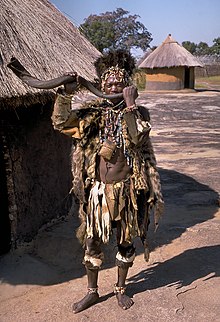Kudu horn

The kudu horn is an African wind instrument that is traditionally used for signal transmission and ritual purposes. It is a cross-blown natural horn and produces two to three tones of the natural tone series .
Manufacturing
It is made from the horns of a species of antelope that lives in South and East Africa , the great kudu . The male kudu animals have twisted horns.
distribution
In southern Africa, especially among the Shona , the kudu horn is used in a variety of ways, including for ritual purposes. In South Africa, the kudu horn and the horn of the sable antelope are known as phalaphala , impalampala or similar. Among the Tsonga, the head of the girls' initiation school ( nhanga ) blows the long kudu horn mhalamhala . It is played along with drums during the initiation ritual. With the Matabele , the natural horn is also used to transmit signals. The ethnomusicologist Paul F. Berliner , who lived with the Shona, also introduced it to world music (among others with Paul Winter , Voices of a Planet ).
An unusual variant that only occurs with the Himba is the onjembo erose , which consists of the conical horn of a skewer , which, with an attached spherical bell made of wax, reaches a total length of 45 to 70 centimeters.
The Nuba in South Sudan had an equally special natural trumpet made from a kudu horn to which an equally long part made of beeswax was attached. The wax forms a spherical thickening in the middle and a slightly conical opening. The Nuba played the prized trumpet mainly at wrestling competitions. In addition to the root , the octave and the duodecime could be generated above the root. The instrument represents a transition between the side-blown natural horns and the end-blown natural trumpets in Africa, which outside of Islamic court culture - like the waza - are always composed of several parts. The combination of a central vessel and a tube is common from South Sudan to the northeast of the Congo and to the east bank of Lake Victoria .
Yemeni Jews used to use kudu horns as a ritual wind instrument shofar on special holidays in Jewish worship.
The instrument is also occasionally used in light music.
Kudu horn in Israeli pop music
Kuduhorn and the Boy Scouts
In 1896 Robert Baden-Powell , the founder of the Boy Scout Movement , took part in a military operation against the Matabele and got to know the kudu horn as a signaling instrument for the local population. As a souvenir of this mission he kept a kudu horn. As early as 1907 at the first boy scout camp on Brownsea , Baden-Powell used the instrument as a signal z. B. for the daily wake-up call. He used it for all signals on the first scout leader training course at Gilwell Park in 1919. Baden-Powell also opened the 3rd world jamboree in Arrowe Park, Birkenhead, England with the Kuduhorn.
Today Baden-Powell's Kuduhorn can be seen in the Museum of Gilwell Park. The Boy Scouts of America still use the kudu horn on Woodbadge courses and Junior Leader Training Conferences.
Peter Duncan, Chief Scout of the UK Scout Association, used the kudu horn at the Sunrise Ceremony on Brownsea 2007 in memory of the first scout camp. The participants were jamborees selected by their national associations to be on Brownsea.
Kuduzela
Kuduzela is the product name for a plastic wind instrument that is modeled on the antlers of the great kudu. Under the name of Kuduzela, the signaling instrument was imitated and successfully marketed as a louder alternative to the Vuvuzela by a South African car manufacturer. The instrument was presented to the public on July 14, 2009 by the head of the South African Nature Park Authority ( SANParks ).
literature
- Anthony Baines: Brass Instruments. Their History and Development . Toronto 1993, p. 34
Web links
- Information and pictures rsp. Graphics of the kudu horn , audio sample (WAV or wave file; English; 100 kB)
- The Kudu Horn and Scouting (English)
- Article on the kudu horn
Individual evidence
- ^ Arthur Morris Jones : African Music . African Affairs 48: 290-297 (1949)
- ↑ Gordon D. Gibson: The Himba Trumpet. In: Man, Vol. 62, November 1962, pp. 161-163
- ^ Klaus Peter Wachsmann: A Rare Nuba Trumpet Collected by the Seligmans. In: Man, Vol. 63, June 1963, pp. 85f
- ↑ Shofar
- ↑ The Kudu Horn of the Matabele. scouting.org.za
- ↑ Where scouting began. BBC, October 9, 2008
- ↑ a b Kuduzela competes with the Vuvuzela
- ↑ 20 minuten.ch of July 15, 2009: Reinforcement for Vuvuzelas - Even more noise: Here comes the Kuduzela - The Tröten faction for the 2010 World Cup is reinforced. In addition to the vuvuzela, South Africa now presents the kuduzela. This doesn't sound like an angry swarm of bees, but like a herd of trumpeting elephants.
- ↑ After the Vuvuzela comes the Kuduzela
